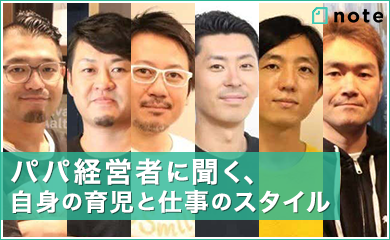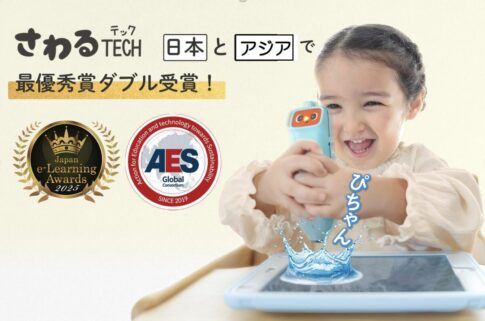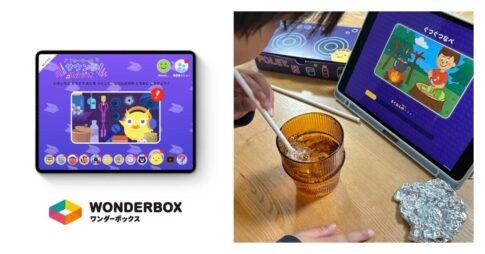- The following is content from the press release -
summary
A research group led by Koji Inui (visiting researcher) of the Developmental Disabilities Research Institute, Aichi Medical and Rehabilitation Center (Kasugai City, Aichi Prefecture; Director: Koichi Nagata), Masaya Suzuki (General Manager, Brain Science Promotion Office) of Tokai Kogaku K.K. (Head Office: Okazaki City, Aichi Prefecture; President: Hirokazu Furusawa), and Natsuko Doi (Deputy General Manager, Planning Group, Toy Business Division) of Pilot Corporation (Head Office: Chuo-ku, Tokyo; President: Fumio Fujisaki), have been working to develop a new type of toy for children. (Head Office: Chuo-ku, Tokyo; President: Fumio Fujisaki), and Natsuko Doi (Deputy General Manager, Planning Group, Toy Division) of Pilot Corporation (Head Office: Chuo-ku, Tokyo; President: Fumio Fujisaki),Developed a method to evaluate the surprise reaction to a change in hair color of a doll (Mel-chan®) using brain waves, and found that the child's ability to feel surprise (the ability to unconsciously notice changes) develops rapidly from birth to 92 months and then becomes almost constant.clarified.
The results of this research were published in the international journal BMC Neuroscience on August 11, 2025.
Research Background
Being "aware" of changes that occur in the environment around you is a very basic ability for human survival. When some change occurs in the environment, the brain has the ability to automatically recognize it. This function is part of a "defensive response" that is thought to be established with development, but until now it has not been clear how this ability to "notice change" is acquired, since it is difficult to assess subjectively or by external observation. In addition, the role of toys in children's development is thought to be significant, but it has not been clarified how unexpected events (surprises) that occur during play also contribute to children's development.
The automatic brain response to change is called "change-related brain activity "1), which can be recorded extremely clearly using EEG2) and magnetoencephalography3). Therefore, our group investigated the ability of school-aged children (6-10 years old) to notice changes using an EEG measuring device suitable for measuring brain activity in children (pediatric patients) and images of a toy (Meru-chan®) that changes hair color.
Research
This study was conducted on 37 healthy children aged 6-10 years (19 males and 18 females; mean 103.6 months). Images of dolls (Mel-chan®, Pilot Corporation Inc.)4) whose hair color changes from brown to pink or rose to yellow, as shown in Figure 1, were shown on the display, and the subjects were asked to quickly press a button when the "image of Mel-chan wearing glasses," which appears only occasionally, appeared. The examinee was asked to quickly press the button when the "image of Mel-chan wearing glasses" appeared. EEG (change-related brain activity) was measured using a headset-type EEG measuring device (TOKAI Orb® Jr.)5) .
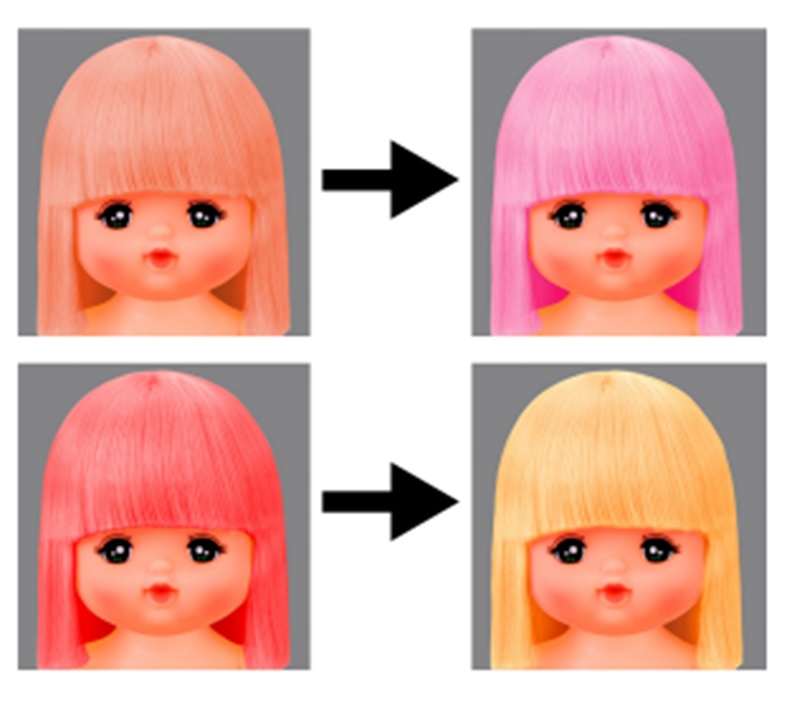
Findings this time
The "noticing" of the doll's (Mel-chan®) hair color change could be recorded by a special EEG component called P130, which appears 100 to 200 ms after the hair color change (Figure 2). This P130 EEG component was measured earlier and larger when the hair color changed from rose to yellow than when the hair color changed from brown to pink. This indicates that the surprise response in the brain is quicker and greater when the hair color changes from rose to yellow.
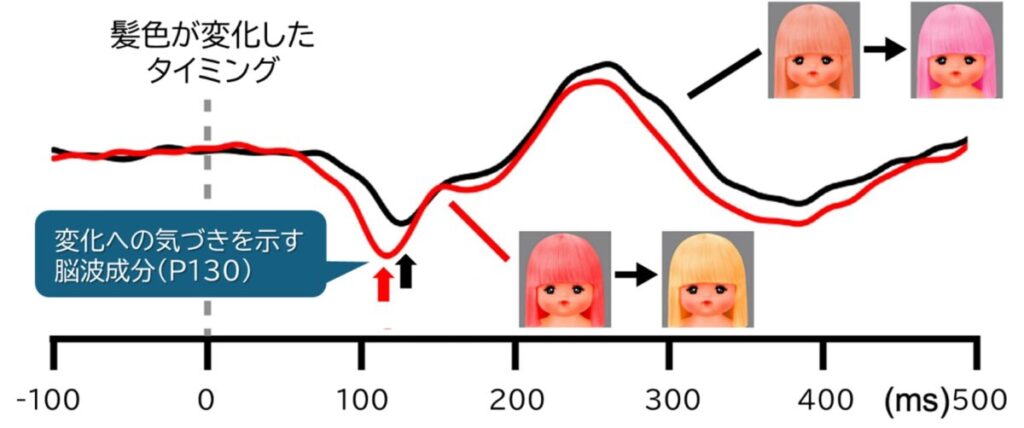
Next, the latency (time to onset) of the P130 component, which indicates awareness of this change, was used to examine the time it takes each subject to notice a change in hair color. As a result, as shown in Figure 3, we found that the noticing of the change became earlier as the age of the child increased from birth to 92 months, and then became almost constant. Although there are individual differences among children, this result indicates that the ability to "notice changes" develops rapidly from birth to 92 months of age.
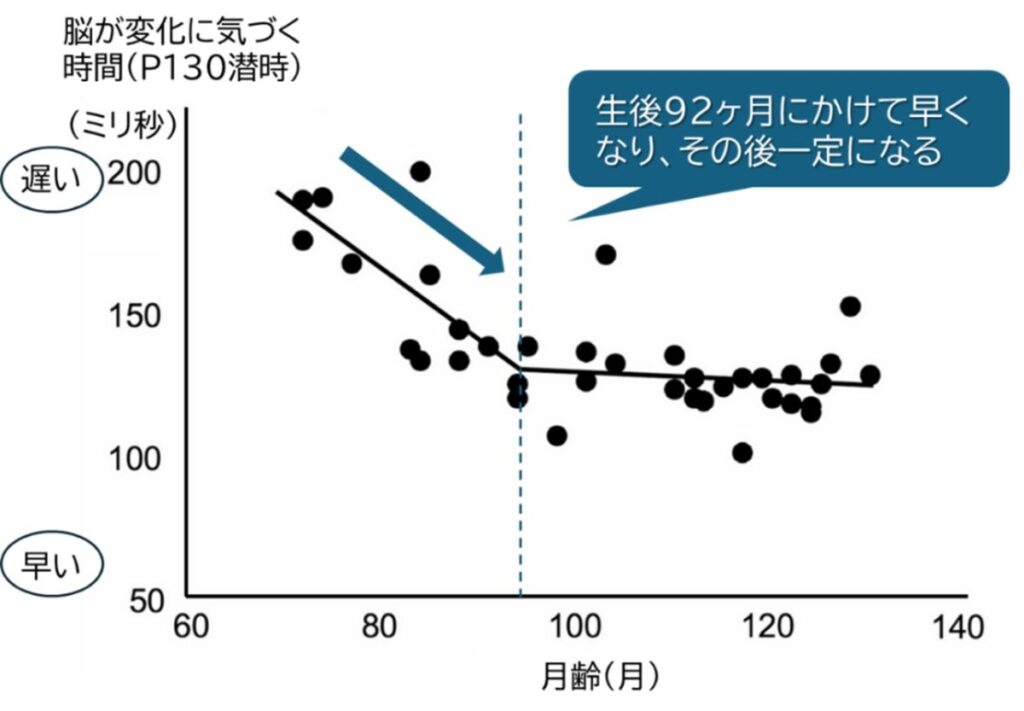
Summary and Future Prospects
- We developed a method to evaluate children's development by using EEG to assess "noticing change" and when we studied children aged 6-10 years, brain activity during "noticing change" was observed very clearly.
- This rapidity of brain activity increases with age, with the ability to "notice change" developing rapidly through the first 92 months of life.
- Therefore, this method can be expected to provide a means of assessing the development of each individual.
- It would also be useful in evaluating toys that involve "surprises" such as color changes. Since the experience of being naturally surprised during play can be expected to contribute to children's development, it seems important to obtain objective data for appropriate toy design and target age setting.
- In fact, based on the findings that the magnitude and rapidity of the brain response varies depending on the color that changes, Pilot Corporation has developed a toy product.6)
Thus, the developed evaluation method may be useful in the evaluation of children's development as well as in the evaluation and design of toys. We are currently conducting studies targeting younger children (3-5 years old) and studies in which the same child is measured multiple times. These studies are expected to contribute to an improved understanding of children's development and to the development of age-appropriate toys and toys that effectively provide a surprising experience.
Paper Information
Journal: BMC Neuroscience
DOI: 10.1186/s12868-025-00970-8
Publication URL:https://bmcneurosci.biomedcentral.com/articles/10.1186/s12868-025-00970-8
Title of paper: Visual change-related brain potentials elicited by changes in doll hair color in school-aged children (Visual change-related brain potentials elicited by changes in doll hair color in school-aged children)
Author(s): Mizuki Kozaki 1), Mine Mizuno 1), Masaya Suzuki 1), Yasuyuki Koike 2), Natsuko Doi 2), Koji Inui 3)
Institutions: 1) Tokai Optical Corporation, 2) Pilot Corporation, 3) Aichi Medical and Rehabilitation Center Developmental Disabilities Research Institute
Publication date: August 11, 2025 (online)
supplementary information
- Change-related brain activity
It is brain activity observed in response to changes in stimuli. It can be recorded as stable brain activity regardless of modality, such as visual, auditory, or somatosensory. In this study, we are measuring change-related brain activity associated with the color change of hair in doll images. - brain waves
The brain contains hundreds of millions of neurons, and information processing in the brain is carried out by the excitation of these neurons. Electroencephalography (EEG) records the electric current activity that flows as a result of neuronal excitation as a potential difference using electrodes placed on the head surface. Brain activity can be determined with a time resolution of milliseconds. - magnetogram
Magnetoencephalography (MEG) measures changes in magnetic fields caused by electric currents that flow as neurons are excited. It provides information on brain activity with temporal and spatial resolution in milliseconds and millimeters. - About Mel
Mel-chan® is a caretaker doll born in 1992, whose hair changes color when she takes a bath. It is a long-selling product that has been loved by parents and children alike for more than 30 years. - Equipment used in this study: Headset-type EEG measuring device TOKAI Orb Jr. (Tokai Optical Co., Ltd.)
The headset-type EEG measuring device TOKAI Orb® Jr. is a headset-type EEG measuring device that can be worn without difficulty on a head circumference of 49 cm to 55 cm (* depending on the head shape) and can wirelessly record EEG and evoked EEG. This device utilizes the results of research and development adopted by the Innovative R&D Promotion Program ImPACT (PM Yoshinori Yamakawa) of the Cabinet Office (2015.6-2019.3) and the Aichi Small and Medium Business Support Fund (2019.10-2020.10). - Toys using the results of this research: "Fruit Daisuki♡ Strawberry Ofuro Set" (Pilot Corporation)
Fruit Daisuki ♡ Strawberry Ofuro Set" is a product whose hair color was determined based on this finding that when the color changes from strawberry to lemon (rose to yellow in the paper), "the surprise response generated in the brain is faster and greater." Launched July 12, 2025.










